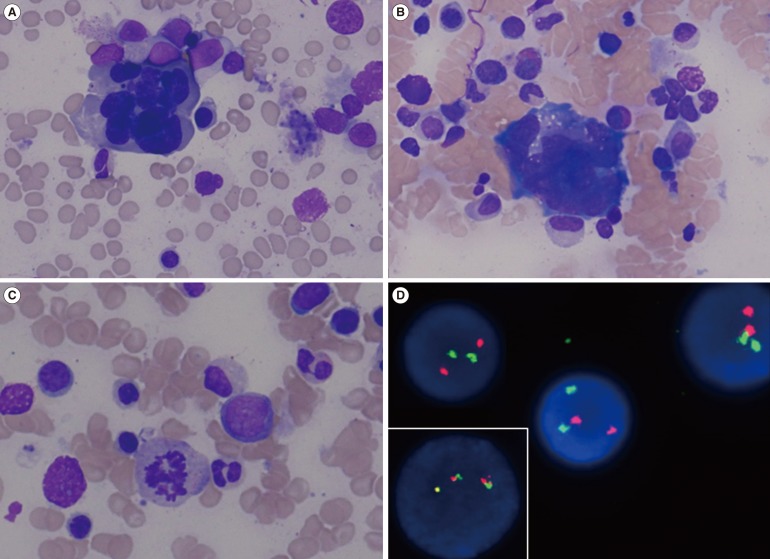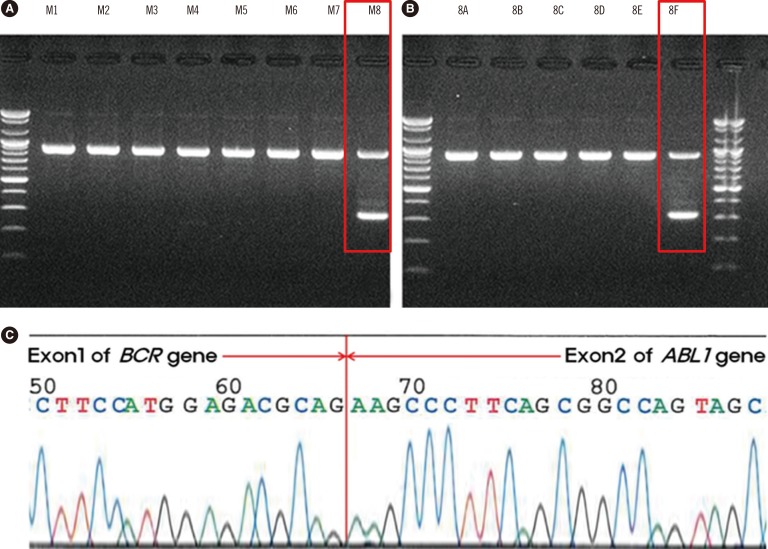Ann Lab Med.
2015 Nov;35(6):643-646. 10.3343/alm.2015.35.6.643.
Cryptic e1a2 BCR-ABL1 Fusion With Complex Chromosomal Abnormality in de novo Myelodysplastic Syndrome
- Affiliations
-
- 1Department of Laboratory Medicine, Chonnam National University Medical School and Chonnam National University Hwasun Hospital, Hwasun, Korea. mgshin@chonnam.ac.kr
- 2Environmental Health Center for Childhood Leukemia and Cancer, Chonnam National University Medical School and Chonnam National University Hwasun Hospital, Hwasun, Korea.
- 3Brain Korea 21 Plus Project, Chonnam National University Medical School, Gwangju, Korea.
- KMID: 2363270
- DOI: http://doi.org/10.3343/alm.2015.35.6.643
Abstract
- No abstract available.
MeSH Terms
-
Aged
Base Sequence
Bone Marrow/metabolism/pathology
Chromosome Aberrations
DNA/chemistry/genetics/metabolism
Fusion Proteins, bcr-abl/*genetics
Humans
Immunophenotyping
In Situ Hybridization, Fluorescence
Male
Myelodysplastic Syndromes/diagnosis/*genetics
Real-Time Polymerase Chain Reaction
Sequence Analysis, DNA
DNA
Fusion Proteins, bcr-abl
Figure
Reference
-
1. Lichtman MA. Myelodysplasia or myeloneoplasia: thoughts on the nosology of clonal myeloid diseases. Blood Cells Mol Dis. 2000; 26:572–581. PMID: 11112390.
Article2. Melo JV. The diversity of BCR-ABL fusion proteins and their relationship to leukemia phenotype. Blood. 1996; 88:2375–2384. PMID: 8839828.3. Kakihana K, Mizuchi D, Yamaguchi M, Sakashita C, Fukuda T, Yamamoto K, et al. Late appearance of Philadelphia chromosome with the p190 BCR/ABL chimeric transcript in acute myelogenous leukemia progressing from myelodysplastic syndrome. Rinsho Ketsueki. 2003; 44:242–248. PMID: 12784657.4. Manabe M, Yoshii Y, Mukai S, Sakamoto E, Kanashima H, Nakao T, et al. Late appearing Philadelphia chromosome as another clone in a patient with myelodysplastic syndrome harboring der(5;12)(q10;q10) at diagnosis. Rinsho Ketsueki. 2012; 53:618–622. PMID: 22790637.5. Fukunaga A, Sakoda H, Iwamoto Y, Inano S, Sueki Y, Yanagida S, et al. Abrupt evolution of Philadelphia chromosome-positive acute myeloid leukemia in myelodysplastic syndrome. Eur J Haematol. 2013; 90:245–249. PMID: 23240925.
Article6. Keung YK, Beaty M, Powell BL, Molnar I, Buss D, Pettenati M. Philadelphia chromosome positive myelodysplastic syndrome and acute myeloid leukemia-retrospective study and review of literature. Leuk Res. 2004; 28:579–586. PMID: 15120934.
Article7. Lesesve JF, Troussard X, Bastard C, Hurst JP, Nouet D, Callat MP, et al. p190bcr/abl rearrangement in myelodysplastic syndromes: two reports and review of the literature. Br J Haematol. 1996; 95:372–375. PMID: 8904895.
- Full Text Links
- Actions
-
Cited
- CITED
-
- Close
- Share
- Similar articles
-
- Isolated monocytosis was the flag preceding abnormalities in other parameters of complete blood counts in chronic myeloid leukemia with e1a2 (minor, P190) BCR-ABL1 chimeric transcripts
- Analysis of Breakpoints of bcr-abl Fusion Gene Using RT-PCR
- Cryptic Insertion of the BCR Gene at 9q34 in Philadelphia-Negative Chronic Myelogenous Leukaemia
- Concurrence of e1a2 and e19a2 BCR-ABL1 Fusion Transcripts in a Typical Case of Chronic Myeloid Leukemia
- A Case of Concomitant Inv(3)(q21q26) and Cryptic BCR/ABL1 Rearrangement in the Blast Crisis of Chronic Myeloid Leukemia



